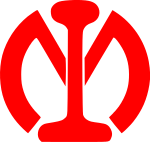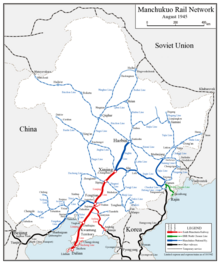South Manchuria Railway
 | |
Native name | 南満州鉄道株式会社 |
|---|---|
Romanized name | Minami-Manshū Tetsudō kabushiki gaisha |
| Company type | Public KK |
| Founded | 26 November 1906 |
| Founder | Government of Japan |
| Defunct | after the Soviet invasion of Manchuria in August 1945 |
| Headquarters | , |
Key people | Gotō Shinpei (first president) |
| Owner | Government of Japan (50%) |
| South Manchuria Railway | |
|---|---|
| Chinese name | |
Hanyu Pinyin | Nánmǎnzhōu Tiědào |
| Transcriptions | |
|---|---|
| Romanization | Minamimanshū Tetsudō |




The South Manchuria Railway (
In 1905, after Russia's defeat in the
However, it was also involved in nearly every aspect of the economic, cultural and political life of Manchuria,[1] from power generation to agricultural research, for which reason it was often referred to as "Japan's East India Company in China". Nisshō Inoue, the founder of the interwar Japanese far-right militant organization Ketsumeidan (血盟団, League of Blood), was employed by Mantetsu from 1909 to 1920.
In 1945, the
History




The main line from Changchun to Port Arthur, as Luishun was called under Russian rule, was built between 1898 and 1903 by the Russians as the southern branch of their
Following the Japanese victory over
Under the authorization of
One of the first tasks of the new company was to change the railway gauge. The rail line was originally built according to the gauge of 5 ft (1,524 mm), during the war it had been
In 1907, an agreement was reached between the Japanese and Russian authorities about connecting the Japanese South Manchuria Railway with the line to the north, which remained in the hands of Russian China Far East Railway. According to the agreement, Russian gauge tracks would continue from the "Russian" Kuanchengzi Station to the "Japanese"
By the end of 1907, the company employed 9,000 Japanese and 4,000 Chinese. By 1910, those numbers had increased to 35,000 and 25,000 respectively.

Mantetsu quickly expanded the system inherited from Russia to staggering proportions, building
From 1916, Mantestu began to spin off a number of subsidiary companies, including
On 31 July 1917, the management of the
Company assets rose from 163 million yen in 1908 to over a billion yen in 1930. Mantetsu was by far the largest corporation in Japan, and also its most profitable, averaging rates of return from 25 to 45 percent per year.[7] During the 1920s, Mantetsu provided for over a quarter of the Japanese government's tax revenues.[9]
Over 75% of Mantetsu's income was generated by its freight business, with the key to profitability coming from soybean exports, both to Japan proper and to Europe. Soybean production increased exponentially with increasing demand for soy oil, and for soy meal for use in
In 1931, the

Mantetsu was also charged with a government-like role in managing the rail transportation system after the formation of
In 1934, Mantetsu inaugurated the "Asia Express", a high speed train from Dalian to the Manchukuo capital of Xinjing (Changchun). Reaching a top speed of 134 km/h (83 mph), the "Asia Express" was the fastest scheduled train in Asia at the time.
Changchun remained the break of gauge point between the Russian and standard gauges in the 1930s,[15] until the Chinese Eastern railway itself was bought by Manchukuo and converted to the standard gauge in the mid-1930s.
In 1936, the company owned 466 locomotives, 554 coaches and 8134 goods wagons.[16]
In 1945, the
Railway dining car service
In conjunction with magazine advertising by Japan Tourist Bureau (JTB), the railway attempted to create a unique food culture in Manchukuo. They offered a variety of special cuisine such as Yamato beef steak,
Network
- Anpō Line: Fengtian–Andong, 260.2 km (161.7 mi)
- Sujiatun–Fushun, 52.9 km (32.9 mi), electrified
- Eikō Line: Dashiqiao–Yingkou, 22.4 km (13.9 mi)
- Endai Colliery Line: Yantai–Yantai Colliery, 15.6 km (9.7 mi), freight only
- Shahekou–Dalian Quay, 6.9 km (4.3 mi), freight only
- Gusai Line: Dalian–Wuqi, 2.9 km (1.8 mi), freight only
- Kanseishi Line: Nanguangling–Dalian Ganjingzi Quay, 11.9 km (7.4 mi), freight only
- Kinjō Line: Jinzhou–Chengzitan, 102.1 km (63.4 mi)
- Kon'yu Connecting Line: Hunhe–Yushutai, 4.1 km (2.5 mi), freight only
- Unggi, Korea, 158.5 km (98.5 mi)
- Namyang36.0 km (22.4 mi) (entirely in Korea)
- Nyūzen Line: Shahekou–Ruchuan Quay, 5.8 km (3.6 mi), freight only
- Najin–Najin Quay, 3.0 km (1.9 mi), freight only (entirely in Korea)
- Renkyō Line: Dalian–Xinjing, 701.4 km (435.8 mi)
- Lüshun, 50.8 km (31.6 mi)
- Ryūshuton Line: Dafangshen–Liushutun, 5.8 km (3.6 mi)
- Chosen Government Railway)
- Chosen Government Railway)
- Yūra Line: Unggi–Najin, 15.2 km (9.4 mi) (entirely in Korea)
Mantetsu presidents


| Name | From | To | |
|---|---|---|---|
| 1 | Shinpei Goto |
13 November 1906 | 14 July 1908 |
| 2 | Yoshikoto Nakamura |
19 December 1908 | 18 December 1913 |
| 3 | Ryutaro Nomura | 19 December 1913 | 15 July 1914 |
| 4 | Yujiro Nakamura | 15 July 1914 | 31 July 1917 |
| 5 | Shimbei Kunisawa | 31 July 1917 | 12 April 1919 |
| 6 | Ryutaro Nomura | 12 April 1919 | 31 May 1921 |
| 7 | Senkichiro Hayakawa |
31 May 1921 | 14 October 1922 |
| 8 | Takeji Kawamura | 24 October 1922 | 22 June 1924 |
| 9 | Banichiro Yasuhiro | 22 June 1924 | 19 July 1927 |
| 10 | Jōtaro Yamamoto |
19 July 1927 | 14 August 1929 |
| 11 | Mitsugu Sengoku | 14 August 1929 | 13 June 1931 |
| 12 | Yasuya Uchida |
13 June 1931 | 6 July 1932 |
| 13 | Hakutaro Hayashi | 26 July 1932 | 2 August 1935 |
| 14 | Yōsuke Matsuoka | 2 August 1935 | 24 March 1939 |
| 15 | Takuichi Ohmura | 24 March 1939 | 14 July 1943 |
| 16 | Naoto Kobiyama | 14 July 1943 | 11 April 1945 |
| 17 | Motoki Yamazaki | 5 May 1945 | 30 September 1945 |
See also
- Rolling stock of the South Manchuria Railway
- Manchukuo National Railway
- Kwantung Leased Territory
- South Manchuria Railway Zone
- Yamato Hotels
References
- ^ a b Kinney, Henry W., Manchuria Today, Dairen, December 1930
- ^ "Changchun II- Le chemin de fer de Changchun" [Changchun II- The Changchun Railway]. CCTV (in French). 28 June 2005.
- ^ ISBN 978-1-113-11167-8.
- ^ Young, Japan's Total Empire, pp 25
- ^ a b Coox, Nomonhan pp.6
- ^ a b Luis Jackson, Industrial Commissioner of the Erie Railroad. "Rambles in Japan and China". In Railway and Locomotive Engineering, vol. 26 (March 1913), pp. 91-92
- ^ a b Coox, Nomonhan pp.21
- ^ Young, Japan's Total Empire, pp32
- ^ a b Young, Japan's Total Empire, pp 31-32
- ISBN 978-0-521-22357-7
- ISBN 978-0-674-01941-6; Harvard University Press
- ISBN 978-0-520-04557-6
- ^ Coox, Nomonhan, pp 1078
- ^ Young, Japan's Total Empire, pp.250
- ^ Yesterday and To-day, The New Zealand Railways Magazine, Volume 6, Issue 8 (April 1, 1932.)
- ^ World Survey of Foreign Railways. Transportation Division, Bureau of foreign and domestic commerce, Washington D.C. 1936. p. 98.
- ISSN 2436-0678. Retrieved October 7, 2021.
Further reading
- ISBN 978-0-8047-1835-6.
- Young, Louise (1999). Japan's Total Empire: Manchuria and the Culture of Wartime Imperialism. University of California Press. ISBN 978-0-520-21934-2.

